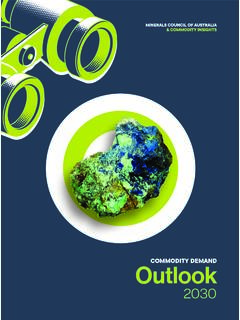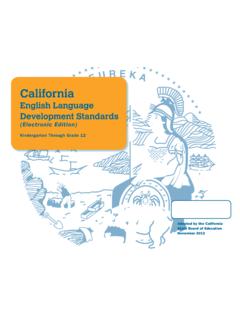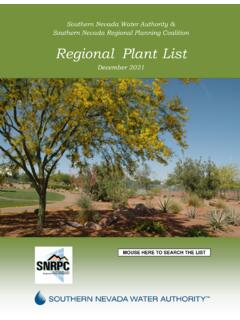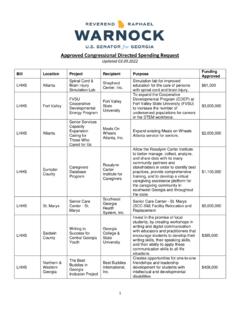Transcription of MINE REHABILITATION - Minerals Council of Australia
1 REHABILITATION is central to the business of miningThe mining industry is continuing its efforts to improve REHABILITATION methods to ensure mining s compatibility with current and future land are required to lodge cash bonds, unconditional financial institution guarantees or non-refundable contributions to pooled funds. This does not remove the obligation for companies to rehabilitate land. Bonds are used only in the unlikely event those obligations cannot be are required to provide detailed operational plans that include careful estimates of REHABILITATION costs. These are reviewed regularly in line with changes in the mine plan, new information or improved REHABILITATION need to demonstrate to regulators that REHABILITATION objectives have been met before the bond is returned and previously mined land can be divested or otherwise handed back to government. Where companies buy or sell a mine, state regulators usually require a matching bond to be lodged by the purchaser before the sale can proceed and the previous owner released from their regulationMine closure planning and REHABILITATION are essential to state-based regulatory approvals.
2 As a condition of approval, companies are required to progressively rehabilitate mined land, where practical. REHABILITATION requirements are specified in regulatory approval conditions. While the future land use can vary, all states require previously mined land to be made safe, stable and non-polluting. Companies must regularly report on REHABILITATION progress in line with their approval conditions, usually a safeguard of last resortState and territory governments require companies to provide some form of financial surety (bond) before mining can These funds are generally intended to cover the full third party costs of rehabilitating mine sites. Typical post-mining land uses include:Crop productionGrazingNature conservationForestryREHABILITATION, CLOSURE PLANNING AND REGULATIONMINE REHABILITATIONR ehabilitation and closure planning throughout the mine lifeWhile much progress has been made, the industry is continuing its efforts to improve REHABILITATION methods to ensure mining s compatibility with current and future land and REHABILITATION are planned and considered across all stages of mine development and operation, from design to closure.
3 The post-mining land use is agreed with regulators, and depending on the size and nature of the mine and the land use option selected, may include input from landholders, communities and traditional owners. Monitoring land post mining will often continue for many years. The industry s approach to mined land REHABILITATION has improved significantly over past decades driven by sustained company investment in research to strengthen the science underpinning REHABILITATION methods, evolving corporate values, community expectations and government regulation. Minerals Council of AustraliaPhone. + 61 2 6233 0600 Email. miningPost miningDuring miningEnvironmental investigationSpecialists collect information on all aspects of the environment to inform the mine REHABILITATION strategy and closure plan. Post-mining land use planning The post-mining land use balances the needs of government, community and traditional custodians engaged in the planning process.
4 The plan requires government approval before mining begins and is refined over the life of a mine & revegetation Soil is placed over the shaped landform. Plant selection depends on future land use, grasses for cattle, crops or vegetation designed to support biodiversity values. Native seeds collected before mining are often used. Native animals may be reintroduced or return REHABILITATION Progressive REHABILITATION is undertaken wherever practical. REHABILITATION requirements are specified in regulatory approval conditions. Companies report on REHABILITATION progress in line with approval conditions, usually on an annual security bonds Companies provide plans, including regularly updated estimates of REHABILITATION requirements. Companies lodge a security bond with government prior to mining which is returned only once the regulator is satisfied agreed REHABILITATION objectives have been Rehabilitated areas are monitored to ensure success:Grazing Soil, pastures and cattle health compared to surrounding propertiesCropping Landform stability, drainage and crop yields Conservation Species abundance and preparation Land clearing is scheduled to minimise impacts on plant and animal species, including local fauna breeding cycles and collection of native seeds.
5 Careful soil management ensures it remains healthy, giving new plants the best opportunity to & habitat protection Plans to protect sensitive plant and animal species, habitat or ecological communities are developed. Companies may establish conservation land to offset any significant residual impacts after the avoid-minimise-mitigate environmental management hierarchy has been & landform designRehabilitation trials inform post-mining land use planning and optimise REHABILITATION management processes. Waste rock is placed in line with the landform design, which aims to be stable and allow water to drain freely. The final design may involve leaving the mine pit to fill with water for use as a water supply, or for recreational or commercial use. Sign-off & relinquishmentOnce REHABILITATION objectives have been met the regulator may sign -off land as having achieved its REHABILITATION objectives. Companies may enter into arrangements with landholders, traditional owners or other groups for future management of the land which may be divested or handed back to Environment Planning and Assessment Act 1979 (NSW), Mining Act 1971 (SA), Mining Act 1978 (WA) Environment Protection Act 1994 (Qld), Mining Management Act (NT), Mineral Resources (Sustainable Development) Act 1990 (Vic), Minerals Resources Development Act 1995.
6 Companies are required to rehabilitate land only when the land becomes Special agreements may apply in certain mining Australian Bureau of Agricultural and Resource Economics and Sciences, Land Use of Australia 2010-11 Summary Statistics, ABARES 2016. 3 Estimates based on MCA review of publicly available data 2013-2016. Current value is likley to be CSIRO, Biodiversity Science and Solutions for Australia , CSIRO Publishing, Canberra, 2014, p. banner: Rehabilitated land at Waroona in the south west of Western of miningAfter rehabilitationDuring operationLifecycle of a mineAlluvial land rehabilitationCoal & Allied, Hunter valley NSWL earn more inside about Coal & Allied s REHABILITATION of alluvial land in the Hunter s Liddell open-cut coal mine has achieved high quality REHABILITATION of grazing pasture, demonstrating mined land can be returned to productive and sustainable grazing trials revealed cattle on the rehabilitated land grew faster and averaged an extra 79 kilograms over cattle on neighbouring pasture.
7 At the abattoir, the extra weight and Productive farming // GlencoreGRAZING condition of the cattle grazed on rehabilitated land returned approximately 25 per cent higher price, or $220 per the trial has not yet concluded, indications are the grazing of cattle on rehabilitated land at the Liddell coal mine is commercially viable and may provide superior pasture compared to surrounding unmined rehabilitationDuring operationRehabilitation work at Cristal Mining s Ginkgo Minerals sands mine in south western New South Wales demonstrates the re-establishment of a semi-arid native vegetation ecosystem in an extremely challenging flora species cover once bare soil and many native lizard and bird species have resettled in the ecosystems // Cristal MiningNATIVE RESTORATIONM onitoring sites measure the progress of rehabilitated areas. An innovative program to count ants, which are a key indicator of ecosystem development, has also been work at the Ginkgo mine demonstrates a commitment to the landscape and developing innovative techniques to return it to a diverse, functioning rehabilitationDuring operationFosterville Gold Mine/Kirkland Lake GoldPLANNING FOR THE LONG TERMThe plan for REHABILITATION of Fosterville Gold Mine in Victoria is still quite broad as the mine is in full operational mode.
8 The aim of the REHABILITATION plan is to return sites to a similar vegetation function and structure as existed prior to mining. If the new landform is significantly different, then the species selection will be appropriate for the final landform rather than what existed mine aims to return areas of native forest back to a self-sustaining native forest while increasing the amount of indigenous species and link up biodiversity corridors where possible. The REHABILITATION practices at Fosterville are well established and frequently reviewed. Goldfields Revegetation has provided REHABILITATION services to the mine since 1989, including seed collection of local indigenous species, seed treatment and propagation, planting and monitoring. REHABILITATION also includes landscaping, topsoiling, ripping and mulching. CSIRO5 Mining stands out from other major land uses ..in terms of the wealth it creates from the limited areas that it directly affects and the relatively short duration of the effect.
9 This provides an opportunity for achieving high standards of environmental management, encompassing mitigation, ecosystem REHABILITATION , and environmental Council of Australia 3 Coal & Allied s REHABILITATION in New South Wales Hunter valley has demonstrated that alluvial land used for mining can be rehabilitated to match the crop production of nearby July 2013 a crop of Triticale, a hybrid of wheat and rye, was planted on the land, the first commercial crop since the productivity trial ended in 2007. Alluvial land REHABILITATION // Coal & AlliedCROPPINGA fter three years of consecutive production, hay yields were above the district Coal & Allied experience has provided new knowledge on the REHABILITATION of higher value agricultural land. The land will continue to be farmed and monitored and will ultimately be a valuable asset to relinquish at the end of the mine rehabilitationDuring operationRehabilitation of the Bluestone Mines Renison Bell tin mine tailings storage facility in western Tasmania is an example of the application of good science and commitment to solve environmental tailings storage facilities (TSF) at Renison, first used in 1968, had a history of discharging elevated levels of dissolved metals, sulphate and Wetland establishment // Bluestone MinesCONSERVATION acidity, which posed a risk to water quality in the adjacent Lake Pieman.
10 Innovative geochemical studies carried out with assistance from CSIRO revealed a way to create a cap to exclude oxygen and neutralise water. Once implemented, water quality rapidly improved and discharges were able to meet environmental standards. After rehabilitationDuring operationJarrah forest REHABILITATION // AlcoaFOREST ECOSYSTEMSA lcoa mines and rehabilitates approximately 600 hectares each year at its Huntly and Willowdale bauxite mining operations in the Darling Range in Western Australia . A key objective of Alcoa s REHABILITATION program is to restore 100 per cent of the plant species that existed in the pre-mined jarrah forest and to accomplish this within 15 months after REHABILITATION is complete, an objective well above government has established its own nursery and has worked in collaboration with local universities, government agencies and private researchers to understand the forest ecosystem. Long term monitoring has shown that most fauna species return to rehabilitated areas once the habitat has rehabilitationDuring operationQUEENSLANDF inancial surety held for REHABILITATION by the state $ SOUTH WALESF inancial surety held for REHABILITATION by the state $ USE Proportion of Australia s land mass occupied by Council of Australia 2




